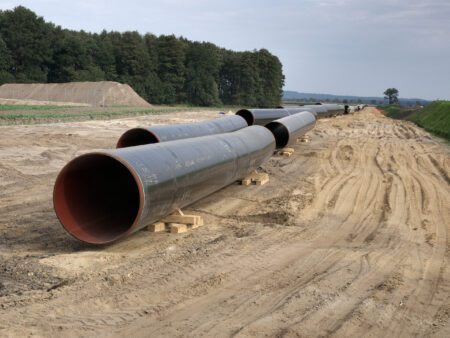
Yet, from that point onwards, the cost of gas has steadily declined to a very comfortable $8 / MMBtu today, which is an incredible turn of events considering the geo-political backdrop. It is also a testament to the determination of European governments to ensure supply security, the ingenuity of the global Liquefied Natural Gas (LNG) industry and the decline of traditional pipelined gas from Russia.
Having been reliant on cheap and easily available Russian gas for so long, European Governments were jolted into action by the war in Ukraine. At the beginning of 2022, 46% of Europe’s gas came from Russia via pipeline, but by the summer of 2022, EU countries had made a 180 degree change in strategic direction. Seaborne cargoes of Liquefied Natural Gas (LNG) were manically snapped up, and tankers bound for Asia diverted into European storage facilities.
At the same time, a huge capital programme rapidly built up coastal gasification facilities (often using covid recovery funds), to allow seaborne LNG to directly discharge into natural gas networks. This mass buying spree by the EU obviously kept global gas prices relatively buoyant in 2023, but as we come to the end of Q1 2024, we have a situation where gas stocks are now at record levels. This, coupled with continued muted demand from China, means that the prospect of a supply-shock (and subsequent gas price escalation) has been significantly reduced.
LNG boom
The fact that there was a plentiful supply of LNG available in the first place, says much for the dynamism and foresight shown by the industry since the early 2000s. It was at this time that the idea of replacing piped gas with seaborne gas was first seriously mooted. Countries such as Australia, Qatar and the USA not only understood the benefit of a product that could literally be sold anywhere in the world, but they also saw that LNG could effectively be used as a bridging fuel towards a lower carbon future (specifically to replace coal).
Huge amounts of money were ploughed not only into the development of gas fields, but also into the capacity to liquefy the product and load it onto ships. This coincided with a massive uptick in LNG ship construction, with the rate of new builds for LNG tankers outstripping crude vessels by 2 to 1 by the beginning of the 2020s.
The boom in LNG has heavily impacted pipeline gas and diminished its importance to global markets. Back in the day, the “Holy Grail” for gas producers was to supply by pipe. Not only was transportation cheap and reliable, but the nature of supply meant there was a captive consumer at the other end. This neatly summed up the situation in Germany from 2000 onwards, as they became increasingly (over) reliant on Russian gas and its “on-tap” nature.
During the volatile days of Spring 2022, the invasion of Ukraine was seen as an economic master-stroke by the Kremlin, pushing the price of the country’s biggest export to astronomical levels and thus amply funding the cost of the invasion. At the same time, the presumption was that European powers would soon cease their support for Ukraine, once they saw just how expensive energy had become.
Not for the first time, market commentators got this one wrong and a look at the financial results of Gazprom (Russia’s state-owned gas company and the only entity permitted to export gas) would bear this out. Having made $11bn of profit in the first six months of 2022, the company saw its earnings halve in 2023 and they now look likely to halve again this year, as both volumes and prices slide.
It’s true that gas exports to China have risen, but the volumes are nothing compared to the pre-war exports to Europe. In 2023, Russia sent 22bn cubic metres (bcm) of gas to China, but that is a trifling amount compared to the 230 bcm it exported to Europe in the decade before the Ukraine war. Furthermore, having so heavily relied on pipeline gas, Gazprom is years behind when it comes to its LNG export capacity.
The increasing fulfilment of global gas demand by LNG has largely been at the expense of pipelined gas from Russia, such that EU leaders are confidently stating that their commitment to eliminate all imports of Russian gas (and oil) by 2027 will be met. When Gazprom’s Nord-Stream pipeline between Russia and Europe was sabotaged, it was almost universally concluded that Russia was responsible.
Having hitherto transported up to half of Europe’s gas, the “self-destruct” conclusion seemed to make sense when, after the event, gas prices initially rocketed. However, subsequent public investigations (carried out by Sweden, Denmark and Germany) have all failed to identify any perpetrators (including Russia), which begs one final tricky question.
Was the deliberate destruction of Nord-Stream an ill-thought out and spectacular own-goal by Russia, or a rather well-thought out and deliberate moving of the dial to an LNG future in Europe?

www.stabilityfromvolatility.co.uk

